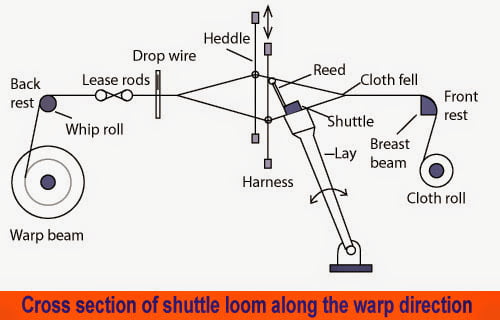Main Check Points in Weaving
Last updated on July 19th, 2023 at 11:51 pm
Constant vigilance of men, machines, materials and atmospheric conditions is required for smooth and efficient working of a loom shed. Though the checkpoints are already known to the supervisors, they must be conscious of these aspects while patrolling the department.

The followings are details of the checklist:
- Conduct a quick round in the loom shed at the start of the shift along with the outgoing supervisor to find out: Back-log of production targets from the previous shift, labour adjustment etc.
- Instruct the humidity attended on necessary adjustments. See that a regular record of temperature and relative humidity in the shed is maintained.
- Monitor the availability of drawn beams to minimize the number of looms being kept idle for want of weaver’s beam.
- Check the availability of weft yarn in the weft storage room.
- Check, at suitable intervals, the weft doffs in the storage room for build characteristics and yarn-content of pirns.
- Conduct a loom-to-loom detailed round to check the quality of production.
- Visit the folding department and collect information from cut-lookers. Point out the major defects to weavers and jobbers and set up a network for follow-up action. Caution the weavers and jobbers who produce a large number of fabric defects.
- Inspect the mechanical condition of the loom at beam fall.
- Inspect the looms producing major smashes and investigate the probable causes for the same. Ensure that the operators mend these smash properly.
- Adopt the sequence of operations while applying new shuttles on looms. Apply a new shuttle on a newly beam-gaited loom only and in the day shift, preferably.
- Inspect the looms at the start of new beams, for: pick density, with the help of a pick glass, reed space, a tape, fabric cover etc.
- Monitor the jobber’s method of gaiting new beams. Ensure that short-term checks are carried out by the jobbers on: shed opening, picker condition, shuttle in shuttle boxes etc.
- Check the warp-stop motions on looms for their functioning by observing the movement of various parts and by pressing down intentionally a drop pin or two to see whether the loom stops.
- Refer to production records for loom-wise and weaver-wise production and efficiency figures. Instruct the weavers who are consistently responsible for low production.
- Refer to the SQC reports for the loom shed’s overall performance in terms of average warp and weft breaks and frequency of other stoppages.
- Refer to the hard waste records for the normal level of hard waste in the loom shed. Particularly, check the sweeping waste.
- Inspect regularly the stores items for quality and consumption. The consumption figures can be obtained from the stores records.
- Observe practices of weavers while patrolling the department. Overlooking floats, not keeping the spare shuttle ready, not taking around in the beam alley, not reporting the machine faults to the jobber, staining the fabric or weft bobbins with oily hands, not mending broken ends in time-specially on ordinary looms, etc. are some of the commonly observed faulty weavers practices. Give proper instructions and warnings, if necessary, to defaulting weavers.
- Observe general cleanliness and housekeeping practices in the loom shed. Ensure that proper cleaning frequencies are followed.
- Inspect the materials handling system and equipment used for transporting weaver’s beams, weft pirns and fabric. Ensure timely maintenance of such equipment.



